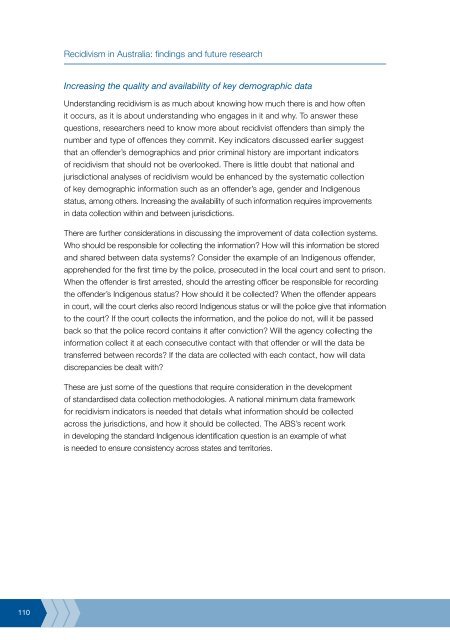Recidivism in Australia : findings and future research - Australian ...
Recidivism in Australia : findings and future research - Australian ...
Recidivism in Australia : findings and future research - Australian ...
You also want an ePaper? Increase the reach of your titles
YUMPU automatically turns print PDFs into web optimized ePapers that Google loves.
110<br />
<strong>Recidivism</strong> <strong>in</strong> <strong>Australia</strong>: f<strong>in</strong>d<strong>in</strong>gs <strong>and</strong> <strong>future</strong> <strong>research</strong><br />
Increas<strong>in</strong>g the quality <strong>and</strong> availability of key demographic data<br />
Underst<strong>and</strong><strong>in</strong>g recidivism is as much about know<strong>in</strong>g how much there is <strong>and</strong> how often<br />
it occurs, as it is about underst<strong>and</strong><strong>in</strong>g who engages <strong>in</strong> it <strong>and</strong> why. To answer these<br />
questions, <strong>research</strong>ers need to know more about recidivist offenders than simply the<br />
number <strong>and</strong> type of offences they commit. Key <strong>in</strong>dicators discussed earlier suggest<br />
that an offender’s demographics <strong>and</strong> prior crim<strong>in</strong>al history are important <strong>in</strong>dicators<br />
of recidivism that should not be overlooked. There is little doubt that national <strong>and</strong><br />
jurisdictional analyses of recidivism would be enhanced by the systematic collection<br />
of key demographic <strong>in</strong>formation such as an offender’s age, gender <strong>and</strong> Indigenous<br />
status, among others. Increas<strong>in</strong>g the availability of such <strong>in</strong>formation requires improvements<br />
<strong>in</strong> data collection with<strong>in</strong> <strong>and</strong> between jurisdictions.<br />
There are further considerations <strong>in</strong> discuss<strong>in</strong>g the improvement of data collection systems.<br />
Who should be responsible for collect<strong>in</strong>g the <strong>in</strong>formation? How will this <strong>in</strong>formation be stored<br />
<strong>and</strong> shared between data systems? Consider the example of an Indigenous offender,<br />
apprehended for the first time by the police, prosecuted <strong>in</strong> the local court <strong>and</strong> sent to prison.<br />
When the offender is first arrested, should the arrest<strong>in</strong>g officer be responsible for record<strong>in</strong>g<br />
the offender’s Indigenous status? How should it be collected? When the offender appears<br />
<strong>in</strong> court, will the court clerks also record Indigenous status or will the police give that <strong>in</strong>formation<br />
to the court? If the court collects the <strong>in</strong>formation, <strong>and</strong> the police do not, will it be passed<br />
back so that the police record conta<strong>in</strong>s it after conviction? Will the agency collect<strong>in</strong>g the<br />
<strong>in</strong>formation collect it at each consecutive contact with that offender or will the data be<br />
transferred between records? If the data are collected with each contact, how will data<br />
discrepancies be dealt with?<br />
These are just some of the questions that require consideration <strong>in</strong> the development<br />
of st<strong>and</strong>ardised data collection methodologies. A national m<strong>in</strong>imum data framework<br />
for recidivism <strong>in</strong>dicators is needed that details what <strong>in</strong>formation should be collected<br />
across the jurisdictions, <strong>and</strong> how it should be collected. The ABS’s recent work<br />
<strong>in</strong> develop<strong>in</strong>g the st<strong>and</strong>ard Indigenous identification question is an example of what<br />
is needed to ensure consistency across states <strong>and</strong> territories.















